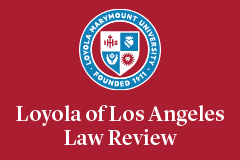Abstract
For years, the California Supreme Court has adopted a deferential posture when reviewing state constitutional challenges to a ballot initiative. The decision in Briggs v. Brown underscored the degree to which courts are willing to avoid striking down ballot initiatives on constitutional grounds, such as by broadly construing the initiative’s language to avoid constitutional problems. In construing the language of Proposition 66 to avoid separation of powers problems, however, Briggs effectively re-interpreted central pillars of Proposition 66 in ways rendering it unrecognizable to Californians who cast votes for and against the initiative. Such recasting of ballot initiatives raises fundamental jurisprudential questions concerning the courts’ ability to regulate the people’s reserved legislative powers vis-à-vis the initiative process. This Article examines the decision in Briggs and evaluates principles of judicial review as applied to popularly enacted ballot initiatives.
This Article discusses various methods of constitutional reasoning, and considers challenges and issues when applying these approaches to the constitutional questions raised by Briggs. Briggs not only raises salient separation of powers issues, but the decision raises practical and political challenges as well. In the end, Briggs arguably limited its inquiry to a particular framework of constitutional reasoning without engaging the full breadth of argument archetypes that would have bolstered its decision in light of various constitutional values, institutional constraints, and political realities. In circumstances where the prevailing analytical framework proves unworkable in the long-run, courts should expand their analytical approach to include considerations such as prudence, history, text, ethics, and structure.
Recommended Citation
Alan Romero, Making Constitutional Sense: A Modal Approach to California's Proposition 66, 53 Loy. L.A. L. Rev. 447 (2020).
Included in
Criminal Law Commons, Criminal Procedure Commons, Election Law Commons, Jurisprudence Commons, Law and Society Commons, Legislation Commons


